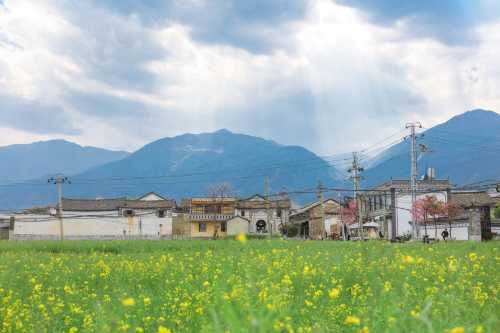Popular Trip Moments
🚗🕒 30 Hours in Dali — Short Trip, Long Memories | 云南 ☁️ Yunnan Sights 🌼 | 🌼 Huayu Ranch (花语牧场), Dali – A Flower Wonderland | 🌿 Wandering Through Dali Old Town – A Charming Mix of Culture,Tea & Street Life | Summer in Yunnan ☀️ 有一种叫云南的生活 🌬 | Sea view room with an oversized terrace | 🌊✨ Erhai Lake – A Must-Visit Gem in Dali, Yunnan! ✨🌊 | Hidden Bai Ethnic Courtyard at the Foot of Cangshan Mountain | The Relaxing Mirror by Erhai Lake, This is the Meaning of Our Encounter | Nestled on the mountainside, encounter Dali's ultimate romance! Yuewan·VILLA awaits your arrival | A must-stay in Dali! This seaside hotel makes me never want to leave | I thought Shuanglang was beautiful enough! Until I visited... | Staying in an Italian-style garden homestay by Erhai Lake in Dali | A Place to Breathe | First Stop: Panxi Village | Escape the City Plan: Journey to Yunnan, Where Spring Lingers All Year Round | Cloud Check-in! Stunning Erhai Lake, Here I Come | To capture these photos, I hired a photographer in Dali for a car-hire photoshoot around the lake! | I'm speechless at the beauty of this Dali seaside homestay – it's a photographer's dream! | Live the life you've always dreamed of in Shuanglang, Dali—no need to rush. | What's the ultimate luxury of staying in a "breathing" hillside hotel?!! | You must visit Erhai Lake at least once | Stayed at the dreamiest homestay in Dali! The vibe is absolutely perfect!! | Sailing towards the sea ~ it's the wind, it's freedom | Waking up by the Erhai Lake in Dali healed my mental exhaustion | Falling in love with the blue hour after the sunset at Erhai Lake over and over again | Back to Dali for some laid-back vibes | A terrace sea-view room that captures the romance of Erhai Lake day and night, located in Shuanglang | Stay at Sanyun River and Encounter the Gentleness of Erhai Lake | It's hard not to fall in love with this hotel's bedrooms!
Recommended Attractions at Popular Destinations
Attraction near Bangkok | Attraction near Manila | Attraction near Tokyo | Attraction near Taipei | Attraction near Hong Kong | Attraction near Seoul | Attraction near Kuala Lumpur | Attraction near Los Angeles | Attraction near Shanghai | Attraction near New York | Attraction near Shenzhen | Attraction near Osaka | Attraction near Singapore | Attraction near London | Attraction near Guangzhou | Attraction near San Francisco | Attraction near Beijing | Attraction near Macau | Attraction near Bali | Attraction near Jakarta | Attraction near Paris | Attraction near Ho Chi Minh City | Attraction near Istanbul | Attraction near Phuket | Attraction near Chicago | Attraction near Seattle | Attraction near Toronto | Attraction near Orlando | Attraction near Cebu | Attraction near Chiang Mai
Popular Attractions
Hungarian Parliament Building | Hong Kong Disneyland | Ferrari World Yas Island | The Yellow Dragon Cave | Wild Wadi Waterpark Dubai | Warner Bros. World™ Yas Island | Elephant Care Park Nai Dee Phuket | Shanghai Circus World | Zayed National Museum | Bund Sightseeing Tunnel | Rajwada Selfie Point | Tianzishan | Dubai Frame | Heihe National Forest Park | Zabeel Park | Chinese Garden Enchoen | Jiaolou Building | The Huangpu River Cruise (Jinling East Road Pier) | Wat Phonjalok | Las Peñas De Los Gitanos | Butterfly Beach | Mosque | Mahadev Temple | Masjid Geliga | Boulders and Badlands Mini Golf | Newtonbrook Creek Park | Mount Edgecombe Golf Lodge | Mesquite Gaming | Taman University Sport & Recreation Club | Sun World Fansipan Legend
Popular Restaurants in Dali
Fireplace Image Wild Mushroom Courtyard Hot Pot | 双廊转角食光·云南菜·花园餐厅 | 江湖笑·野生菌火锅 | Ruoshui 3000 Restaurant | Moshanghuayuan Restaurant | Linden Centre | Er Yue Restaurant | 红利私厨•白族私房菜(玉洱路老店) | Green Field Kitchen | 四方街食店 | 丽舍咖啡吧 | 醉琉璃·藏好私房菜 | ba mu xuan | Royal Restaurant | Duan Gongzi's Dali Bai Ethnic Cultural Experience Restaurant | 大理悦湾·VILLA半山海景酒店·咖啡厅 | 老宅子私房菜馆(大理古城店) | 正宗保山铜瓢牛肉(五台路店) | 香村老汉木桶鱼.酸菜鱼(开发区火车站店) | 花与菌·野生菌火锅(古城洱海门店) | 凤翔饭庄·洱海畔的味道 | 留白LIUBAI·菡萏驿海景度假酒店·留白Villa·菡萏驿海景餐厅(双廊店) | Ting Yuan· Private Kitchen | Yun Qin | Baizufengweiguan (dafei) | 复兴小院·私房菜(古城店) | FORTEN | 朴石烘焙 SIMPLE STONE BAKERY | 格外小馆(双廊店) | Jin Sheng You Yuan
Popular Ranked Lists
Popular Premium Hotels in Rakovnik District | Popular Must-Visit Restaurants in Florence | Top 10 Local Restaurants in Mudanjiang | Popular Best Things to Do in Zhuji | Popular Best Things to Do in Taishan | Top 3 Local Restaurants in Xinyuan | Popular Best Things to Do in Huangshi | Top 6 Best Things to Do in Xiangshan | Popular Premium Hotels in Durango | Popular Best Things to Do in Jieyang | Top 5 Best Things to Do in Huaihua | Popular Premium Hotels Near Kamyzyaksky District | Popular Must-Visit Restaurants in Kyoto | Popular Premium Hotels in Nikos Kazantzakis | Popular Must-Visit Restaurants in Chaozhou | Popular Local Restaurants in Bangkok | Top 3 Best Things to Do in Linxia Prefecture | Popular Best Things to Do in Pingxiang | Top 4 Best Things to Do in Yingkou | Top 7 Best Things to Do in Jining | Popular Premium Hotels in Pizzo | Popular Premium Hotels in Durango | Top 15 Best Things to Do in Ganzi Prefecture | Popular Must-Visit Restaurants in Santorini | Popular Premium Hotels in Oudtshoorn | Popular Premium Hotels in Kurvande | Popular Premium Hotels in Howrah | Popular Premium Hotels in Scarborough District | Top 19 Local Restaurants in Singapore | Popular Must-Visit Restaurants in Yangzhou
Payment Methods
Our Partners
Copyright © 2025 Trip.com Travel Singapore Pte. Ltd. All rights reserved
Site Operator: Trip.com Travel Singapore Pte. Ltd.
Site Operator: Trip.com Travel Singapore Pte. Ltd.









